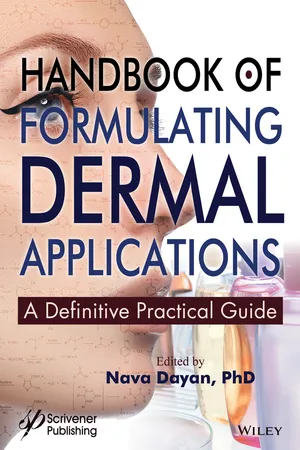
- English
- ePUB (mobile friendly)
- Available on iOS & Android
About this book
The conceptualization and formulation of skin care products intended for topical use is a multifaceted and evolving area of science. Formulators must account for myriad skin types, emerging opportunities for product development as well as a very temperamental retail market.
Originally published as "Apply Topically" in 2013 (now out of print), this reissued detailed and comprehensive handbook offers a practical approach to the formulation chemist's day-to-day endeavors by:
- Addressing the innumerable challenges facing the chemist both in design and at the bench, such as formulating with/for specific properties; formulation, processing and production techniques; sensory and elegancy; stability and preservation; color cosmetics; sunscreens;
- Offering valuable guidance to troubleshooting issues regarding ingredient selection and interaction, regulatory concerns that must be addressed early in development, and the extrapolation of preservative systems, fragrances, stability and texture aids;
- Exploring the advantages and limitations of raw materials;
- Addressing scale-up and pilot production process and concerns;
- Testing and Measurements Methods.
The 22 chapters written by industry experts such as Roger L. McMullen, Paul Thau, Hemi Nae, Ada Polla, Howard Epstein, Joseph Albanese, Mark Chandler, Steve Herman, Gary Kelm, Patricia Aikens, and Sam Shefer, along with many others, give the reader and user the ultimate handbook on topical product development.
Frequently asked questions
- Essential is ideal for learners and professionals who enjoy exploring a wide range of subjects. Access the Essential Library with 800,000+ trusted titles and best-sellers across business, personal growth, and the humanities. Includes unlimited reading time and Standard Read Aloud voice.
- Complete: Perfect for advanced learners and researchers needing full, unrestricted access. Unlock 1.4M+ books across hundreds of subjects, including academic and specialized titles. The Complete Plan also includes advanced features like Premium Read Aloud and Research Assistant.
Please note we cannot support devices running on iOS 13 and Android 7 or earlier. Learn more about using the app.
Information
SECTION I:
Preliminary Considerations and Selection of Raw Materials
CHAPTER 1
Pre-formulation Design and Considerations
Key Words
Introduction
Project Goals and Formulation Design
- Project objective is clear and the concept and goals are stated.
- Value proposition is clear; benefit provided to the consumer is stated, budget for project is specified.
- Distribution (limited vs. global) is determined.
- Budget limitations are identified and isolated.
- Desired technologies are described in general terms.
- Desired claims for the product are defined; what is this product’s end game?
- Target site of application is determined (i.e. the hair, face, body, or a combination of sites).
- An intellectual property search is conducted, where in known regulatory and patent restrictions are identified.
- Potential market analysis observations are conducted.
| Reference Source | Publisher |
| International Cosmetic Ingredient Dictionary and Handbook | Personal Care Products Council, Washington, DC |
| British Pharmacopoeia | The British Pha... |
Table of contents
- Cover
- Title page
- Copyright page
- Preface
- Section I: Preliminary Considerations and Selection of Raw Materials
- Section II: Formulation, Processing and Production Techniques
- Section III: Testing and Measurements Methods
- Section IV: Sensory and Elegancy
- Section V: Stability and Preservation
- Section VI: Color Cosmetics
- Section VII: Sunscreens
- Glossary of Terms, by Chapter
- Author Biographies
- Index
- End User License Agreement